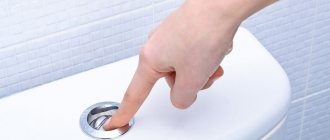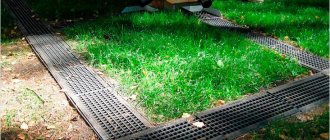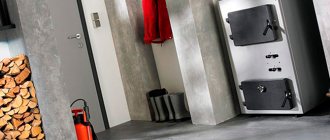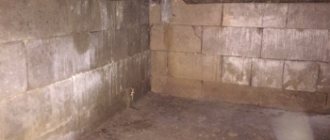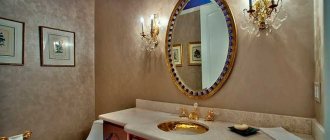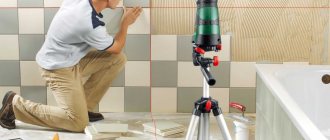Mold is the most ancient organism that appeared on Earth long before plants and animals. When we hear about it, expired products or damaged repairs immediately come to mind. Unfortunately, mold is very common and causes the most discomfort in the bathroom, appearing on the walls, floors and ceilings. There are a large number of methods to combat the problem, but not all of them are equally effective.
What is the difference between mold and mildew
Mold is a representative of the fungal kingdom, so there is no difference in everyday life between fungus and mold. Mushrooms are a biological organism that consists of mycelium - the main part located inside the substrate (under wallpaper, soil, plaster) and reproductive organs located above the surface. Mold feeds on organic matter, but does not need sunlight and does not process carbon dioxide like plants do. These organisms, on the contrary, emit carbon dioxide, as well as some minerals and essential oils, due to which they have a characteristic odor.
The most common fungus that affects bathrooms is mold. It has a black, brown, bluish or greenish color; luminous (phosphorescent) colonies of fungi may appear on the walls in the bathroom. They can live on almost any surface where there is access to moisture - concrete, stone, paintwork. Most often, mold begins to develop in the bathroom between the seams of the tiles and in the places where the plumbing joins the walls, in the corners under the ceiling above the bathtub or shower. The first signs of a problem:
- the appearance of an unpleasant damp smell,
- the formation of single black or brown dots on the walls or ceiling.
Mechanical method of removing fungus
One of the tools you will need to remove fungus mechanically is a spatula.
When black spots appear on the sealant in the joints between tiles in the bathroom or on the walls in living areas, the affected coating must first be removed. Different tools are used for this:
- putty knife;
- steel brush;
- grinding attachment (installed on the drill);
- sharp knife, etc.
To prevent the spread of spores through the air (the main method of contamination of surfaces), the cladding must be treated with water. To do this, it is recommended to use a spray bottle. If you use a sponge or rag, some of the spores will become airborne when the material comes into contact with the surface. When the fungus has already penetrated the structure of wood or concrete, the milling method is used. When the infection is severe, mold is also found on inorganic surfaces. If you plan to fight it yourself, it is important to follow the instructions:
- The surface is moistened with water from a spray bottle.
- They free load-bearing structures from cladding: wallpaper on the walls, whitewash on the ceiling, flooring. This will allow you to get to the mycelium.
- If it turns out that the mold has penetrated deeper into the structure of the material of the supporting structure, remove the layer of plaster. It is necessary to clean the wall down to the rough base - brickwork, concrete.
At the next stage, chemicals are used. However, if the preparatory work (mechanical cleaning) did not provide the required result, special means will not destroy the fungus. It will continue to develop on the adjacent site.
Chemical agents can also be used against fungus.
Causes of mold in the bathroom
For active growth of mold, appropriate conditions are necessary - high air humidity, low temperature and the absence of ultraviolet radiation. In apartments and houses, in particular bathrooms, mold can occur for the following reasons:
- poor ventilation system. If the air in the room is stagnant, the moisture does not come out, but settles as condensation on the surfaces. The optimal humidity for the active spread of spores is 90–95%,
- poor heating. The optimal temperature for mold development is 20°, while the fungus can live at lower temperatures; some of its species thrive at 0°. Fungus on the walls often appears in bathrooms that are poorly heated,
- Construction Materials. For rooms with high humidity, special materials are required, for example, primer, putty, paint with antiseptic components, as well as moisture-resistant building blocks, drywall, and grout. The use of such compositions will make it possible to prevent the appearance of mold,
- construction errors. Poor insulation and waterproofing of walls leads to them getting wet and freezing, as a result of which mold begins to eat them from the inside, which can subsequently lead to the destruction of the building.
Danger of mold in the bathroom
Of course, molds are dangerous, but not on such a scale as many imagine. Harm from these organisms can be divided into two groups:
- harm to the home. Fungal colonies develop very actively, penetrating deep into building materials and destroying them. If the renovation is done poorly or materials for rooms with high humidity are not used, there is a risk that mold will begin to develop deep inside the walls, hiding under the tiles and plaster. In this case, over time, the facing material will begin to fall off and the only method of combating the fungus will be knocking down the walls to the brick. Surface mold spreads across the walls and ceiling in dark spots, causing aesthetic discomfort and a feeling of unsanitary conditions,
- harm to human health. If there is mold in a room, then its microscopic spores are constantly in the air, as a result of which a person inhales them. In small quantities, the effect of fungus on the body is imperceptible, but if you live in an apartment with a large amount of mold for a long time, the result will be noticeable. The main harm of mold is the risk of allergic reactions. Fungal spores contribute to the appearance of inflammatory processes in the body, which causes dizziness, lacrimation, weakness and other asthenic symptoms. Another danger is diseases of the respiratory system, including asthmatic syndrome.
Products used for repair work
To avoid mold contamination of walls for a long time, builders use highly effective fungal repellents.
Copper sulfate and special primers or emulsions applied to the wall will not only completely destroy the fungus that appeared before the repair, but will also prevent its reproduction in the future.
Let's take a closer look at how these tools work:
How to remove mold stains with copper sulfate?
This is one of the most effective remedies for fungus. Copper sulfate, which can be bought for 150 rubles, can protect walls from mold for a long time.
To treat surfaces, dilute the following solution:
- take 100 gr. vitriol;
- 10 liters of water.
Apply the product to the wall with a brush . In places where the fungal infection is very strong, the wall is covered with a solution in several layers.
When 3-4 hours have passed, the wall is washed and dried.
Copper sulfate must be handled very carefully because this product is very toxic. When working with it, you need to ventilate the room well, and also use a respirator and gloves.
Antiseptic emulsions
These drugs include antifungicides that protect against biocorrosion. They are made on the basis of QAC (quaternary ammonium compounds) and guanide.
For the bathroom, Renogal is suitable for 360 rubles, which can remove mold even from the seams between the tiles.
The following tools are also popular among users:
- antiseptic “Abedis 06 Barwa Sam” for 250-300 rubles;
- “Snowball Puma” for 80-100 rubles;
- emulsion “Alpina Ground” for 300-350 rubles.
Primers
Before using these products, you need to prepare the surfaces. A layer of whitewash or paint is removed from the walls and ceiling, and the plaster is dried using a hair dryer.
You need to work in a respirator so that mold pores do not enter the respiratory tract.
The finished walls and ceiling are treated with an antifungal emulsion or other product.
Among the popular means:
- “Ceresit CT-99” antifungal primer costing 360-400 rubles;
- primer "Caparol Capatox" for 650-700 rubles;
- "Bairis BioStop" for 200-250 rubles.
Procedure for removing mold
The choice of strategy for combating mold largely depends on the depth of fungal damage to surfaces. The larger the area of infection, the more difficult it is to combat the problem. Conventionally, the entire process can be divided into the preparation and processing stage.
Preparation stage
The preparatory stage consists of removing the top layer affected by the fungus, and if this is not done, mold will soon appear in the same place again. Working with walls covered with wallpaper or painted is much easier than with those on which tiles are laid. Depending on the type of surface, the following measures can be applied:
- Tile. The main affected area is the seams filled with cement grout, or the junction of the tiles with the plumbing, which are filled with sealant. To get rid of the fungus forever, you need to carry out the following actions: jointing - an event to remove colored filler from the tile joints. This procedure can be carried out using a special tool that resembles a grinder (grinder). Mechanical tools are also used, for example, a screwdriver, chisel, dental instrument,
- drying - removing moisture and microscopic spores from the seams using a thermal method. For this you can use an autogen, a hair dryer, a blowtorch,
- knocking - if the fungus has affected not only the seams between the tiles, but also covers the tiles on top, there is a high probability that mold spores are deep in the wall. In this case, you will have to knock down the cladding, tile adhesive, plaster, removing all affected layers,
- Remove wallpaper - remove sheets damaged by fungus from the walls.
- Mechanical cleaning - the surface is cleaned using a damp cloth and a hard sponge.
Processing stage
Treating walls against mold involves applying special disinfectant compounds to a surface that has been damaged by fungus. It is necessary to carry out the treatment only after the wall or ceiling has been cleaned and completely dried. This procedure can be carried out using professional (store-bought) or folk remedies. Processing involves two key tasks:
- disinfection - the use of highly alkaline or caustic acidic substances to destroy residual fungal spores,
- protection - creating an environment in which mold cannot grow in the future.
Depending on the area of the damaged plane and the shape of the product, the following tools can be used:
- brush for applying the composition to the wall,
- roller for processing horizontal surfaces (floors and ceilings),
- container for disinfectant composition,
- spray bottle for spraying products onto walls,
- compressor sprayer for treating large areas.
The bathroom mold treatment process may look like this:
- Apply anti-fungal agent to a clean and dry surface in any convenient way.
- Drying the treated surface naturally to ensure complete drying of the composition.
- Removing loose or granular preparations using a hard sponge or dry cloth.
- Ventilate the room, treat the walls with an ultraviolet lamp for several hours.
Safety precautions
At the preparatory stage and during the process of treating walls with special means, it is necessary to follow safety regulations. To do this, use personal protective equipment:
- respirator,
- latex gloves,
- protective glasses that fit tightly to the face,
- clothing that completely covers arms and legs.
At the preparation stage, safety precautions ensure protection of the respiratory organs and mucous membranes from the ingress of fungal spores and particles of building materials, and during processing they protect the respiratory organs and mucous membranes from chemical vapors, and also protect the skin from chemical burns from aggressive acids and alkalis.
Household chemicals
Designed to effectively remove fungus, household chemicals can clean contaminated surfaces several times faster than any folk remedy.
If you are not allergic to the components of antifungal drugs and there are no pets in your apartment, then feel free to use special anti-mold chemicals.
"Belizna" - chlorine-based solution
The most famous and inexpensive product called “Whiteness” for 50 rubles. Excellent removes mold stains from various surfaces.
Spraying a bleach solution onto a whitewashed ceiling will remove mold stains and stop mold growth.
To prepare the solution:
- Bleach is diluted with water in a ratio of 1 to 10.
- Apply it to a cleaned surface and wait for it to dry.
The disadvantage of this product is the specific smell of chlorine.
Oxygen bleach
It is based on sodium percarbonate , which can cope with different types of mold.
This product is well suited for removing stains from colored surfaces. With its help, you can remove fungus from curtains in the bathroom, remove black stains from tile joints, curtains, etc.
There is a large selection of such bleaches on sale. The most famous:
- "Bos Plus" costs about 30 rubles;
- “Sano Oxygen”, it can be bought for 280-300 rubles;
- “Vanish Gold” for 140-150 rubles.
Special antifungal
They are distinguished by their speed of action and efficiency . Thanks to it you can clean:
- plumbing;
- shower cabin;
- tiles
Cleaning surfaces will take from 10 minutes to an hour . Example:
- “Cillit Bang”, price 150-170 rubles;
- spray “Unicum”, costing about 180 rubles;
- “Turbo”, priced at 300-350 rubles.
Mold Removers
To combat mold, topical agents are used to disinfect the treated surface and prevent the appearance of fungus in the future. All formulations for local use are divided into folk remedies and purchased professional preparations.
Folk remedies for fungus
Folk remedies are used to treat walls against mold in order to remove small superficial lesions. The following recipes are the most popular:
- white. We dilute the whiteness with water in a ratio of 1:10, mix the solution, after which the treatment can be carried out. To enhance the effect, bleach is poured with boiling water - this makes the solution more dangerous for mold fungi. The resulting composition must be applied to the cleaned surface using a rag or spray bottle. The solution does not require subsequent removal; it should dry on its own. When working with bleach and other caustic liquids, it is necessary to ensure a constant flow of fresh air in the room,
- vinegar. To treat the surface, use ordinary 9% table vinegar, which is applied neat to a cloth and wiped the problem areas. After a while, after the product has dried, the treated area should be wiped with a damp cloth and the room should be ventilated well so that the smell of vinegar is completely gone.
- copper sulfate. Copper sulfate is an antiseptic in bulk form. To prepare the drug, you need to dissolve a pack of powder (100 grams) in 10 liters of running water. The resulting product is applied to areas that need treatment using a brush. Copper sulfate solution is very caustic, so it should be used with a respirator, safety glasses and gloves. 4 hours after treating the walls and ceiling, the composition is washed off with a sponge, after which the room must be ventilated.
The residential building in which the apartment was located was built 30 years ago and no major renovations have been carried out. I immediately noticed the walls in the apartment: the wallpaper was falling off, the walls and ceiling were black, the hood was weak. To which my mother-in-law told me that they had mold for a long time, the housing department did not respond to verbal complaints. When the wallpaper above our bed tore off almost to my nose, when I was quietly and peacefully snoring at night, I decided to take action! After treating the walls, we waited a few days for the walls to dry and hung new wallpaper. At the same time, 1 tablespoon of copper sulfate was added to the glue to prevent the formation of fungus. But, unfortunately, a year later the situation resumed. The problem turned out to be more global than we thought, we had to get the housing office to insulate the walls
Junonoshka
https://irecommend.ru/content/spravlyaetsya-li-mednyi-kuporos-s-plesenyu-v-kvartire-kak-polzovatsya-mednm-kuporosom-ot-gri
I had a lot of mold growth in my bathroom when I started it. Now I've brought it out. But as soon as you relax, it creeps in again. So we need to adopt the good old method of hospital and school cleaners - bleach. Buy more “Whiteness”, put it in the sprayer and rinse everything thoroughly. I had it on the ceiling, so I “whitened” the entire ceiling with ordinary bleach using a brush. Whiteness, whiteness again (or bleach). Constantly, as soon as it appears somewhere, spray. This will always have to be done. Less often when there is good ventilation. Throw away the rags you use to wipe infected areas immediately. Fans and once again fans in all ventilation shafts. Windows must have slits or be in micro-ventilation mode (if plastic). Fans will create the necessary circulation. I sometimes turn on an old Soviet quartz lamp. If you find it, turn it on. This crap is very afraid of UV. When working with pure bleach, you need a damp bandage over your mouth and nose, and glasses on your eyes. Windows and doors are wide open. I almost gave it to the oak tree.
user55
https://forum.onliner.by/viewtopic.php?t=2191871
In general, I couldn’t wait to go to the store for vitriol. I watered it with undiluted Domestos and it stayed that way. Then I washed it off and wiped it with vinegar - I remembered something from a chemistry course about vinegar and mold. I dried and painted everything there. I’ll keep an eye on it, but I hope it will go away after this treatment. Some people have a hard time withdrawing, while others go through it quickly. A friend’s corner behind the closet in her house was covered in mold, for a long time now, I called her to ask what they treated it with. So she says, she just painted this corner, their walls need to be painted. And mold no longer appeared.
Lena
https://eka-mama.ru/forum/part20/topic301115/?PAGEN_1=2
Store-bought mold remedies
There are antiseptics whose action is aimed at destroying fungal infections. The most popular drugs are:
- Dali is a product in liquid form, based on an aqueous antiseptic solution. Available in volumes of 0.6 and 6 liters, has no unpleasant odor, is safe for people and animals, suitable for treating all types of surfaces to prevent and destroy fungus,
- HG is a universal solution in the form of a solution for removing all types of fungus in rooms with extreme conditions and high humidity. Sold in a 500 ml bottle with a spray bottle. Sprayed onto areas affected by fungus, quickly and effectively destroys mold spores and mycelium, designed to eliminate local growth on all types of coatings,
- "Antifungal Abedis" 06 is a liquid concentrate produced in volumes from 0.5 to 20 liters. Used for local disinfection of surfaces and prevention of fungus during construction work. Suitable for adding to building mixtures to increase the barrier properties of materials to fungal infection. Non-toxic, has no pungent odor, applied with a brush in its pure form to combat mold. For preventive use, it is diluted with water in a ratio of 1:2.
Purchasing a new apartment is not only a great joy, but also a huge concern for repairs. In addition, we did not buy living space in a new building. Before us, the owner of the apartment was an elderly woman who apparently did not pay attention to the condition of her bathroom and small black dots of mold appeared on the walls. Many have already heard that fighting this infection can take a long time and to no avail. But our renovation couldn’t stay idle for long due to fungus. After reading reviews from experienced craftsmen and consulting with the workers who were hired to lay the tiles, my husband and I opted for the universal antiseptic “Dali.” We treated the walls in the bathroom three times, each time allowing them to dry thoroughly. It turned out that the consumption of antiseptic is very economical - a little more than a bottle was needed for a room of 6 square meters. But it was possible to process it twice, but for our own confidence we played it safe. A little over a year passed, and we didn’t even think about mold. Good results for an inexpensive product.
morkovka
https://otzovik.com/review_3188334.html
Our apartment is not just damp, but very damp, and, as a result, black mold is our constant neighbor, which is very difficult to get rid of. We tried a lot of remedies, some well-known and some not so good, they certainly help, but you also have to scrub a lot. Mold has settled in the kitchen on the ceiling (and there is whitewash that I don’t really want to wash) and the bathroom. We stopped at the store and were recommended the HG fungus and mold remover, we bought it, it wasn’t cheap, but... We came home, tried it and... you just spray it on the mold and it immediately disappears before your eyes - you wash it with a cloth and everything... perfectly clean. In the Bathroom everything is the same, even on the seams of the tiles you spray and everything flows down, you wash and... it’s very clean and there’s no mold. And it is used very economically.
iri9947
https://otzovik.com/review_2626727.html
Professional services
If mold reappears after numerous treatments or the affected area is too large, you can use the services of private companies. The advantage of professional fungal control organizations is that they bear full responsibility for the work performed and guarantee 100% results, which cannot be achieved by using any purchased drugs on your own. Such services use specialized equipment and products with low toxicity, which makes it possible to eliminate mold in residential areas where people and animals constantly live.
How to dilute white to remove mold?
One of the main questions is: how to dilute white to eliminate mold and whether it is worth diluting it at all. Usually yes, an aqueous solution is made: you need to dilute the white in a 1:1 ratio with water.
It is not advisable to make a weaker concentration - the product will simply be less effective against mold colonies. Small concentrations (1:5, for example) are used for other purposes (for example, to disinfect toilets or washbasins in hospitals).
It is also possible to apply pure bleach without dilution, but this is actually a nuclear mixture, and it is better to use the product in this form only for basements and attics (primarily because the finishing materials will definitely change color from such exposure).
Safety precautions when working
It is extremely important to use whiteness correctly, that is, adhere to all prescribed safety measures.
The basic rules are:
- it is necessary to work in special protective clothing - use a respirator (but not gauze, it is ineffective), thick pants, rubber gloves, glasses (even ordinary ones will do, but construction glasses are better);
- work must be carried out in a ventilated area - therefore, all windows and doors should be opened, and exhaust systems should be turned on (if any);
- It is extremely important not to allow the product to come into contact with open areas of the skin and especially the mucous membranes - this can result in a severe burn;
- The brushes used for disinfecting work must then either be thrown away or left for the next work with whiteness, but for nothing else (they cannot be used in any other work).
Preventing mold in the bathroom
Fighting mold is much more difficult than preventing its occurrence. There are some recommendations that allow you to effectively prevent the appearance of fungal infections in bathrooms and rooms with high humidity:
- During construction work, it is necessary to carry out basic treatment of “wet areas” with special antifungal drugs. For bathrooms, it is important to use materials that contain antiseptics that prevent the appearance and spread of fungal infections,
- It is necessary to ensure effective ventilation and airing of bathrooms. To do this, use a forced active ventilation system by installing an electric fan in the ventilation duct,
- In winter, it is necessary to ensure good heating of the room. To do this, at the construction stage, warm floors, large coils, and stationary heating devices are installed.

